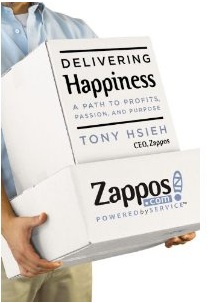 It was a real treat last week at a conference to hear a down-to-earth keynote speech from a guy who’s had two start up company exits between 1998 (LinkExchange, sold to Microsoft for $265 million) and 2009 (Zappos to Amazon for $1.2 billion).
It was a real treat last week at a conference to hear a down-to-earth keynote speech from a guy who’s had two start up company exits between 1998 (LinkExchange, sold to Microsoft for $265 million) and 2009 (Zappos to Amazon for $1.2 billion).
Tony Hseih (pronounced Shay), an investor, CEO, serial entrepreneur, and author shared wow insights about growing businesses, building a killer company culture, hiring and working with (the best) employees and the greatest non-marketing non-advertising) strategy ever.
Tony Hseih’s new book Delivering Happiness, A Path to Profits, Passion and Purpose will be out on June 7, 2010. In the book he’s sharing his insights, success and mistakes. And Tony wants other businesses to avoid the mistakes he’s made.
Here are highlights from Tony’s speech at the HBS Business Growth Summit that I think can benefit small all business owners:
Early on in Zappos’ life as a start up company, the management team decided they were a “customer service company that happens to sell shoes and clothing.” All decisions were then based on how do we create the best customer experience possible? No lip service here. Zappos went from zero to over a billion dollars in sales in less than 10 years.
Where Do You Invest Capital?
How to invest your capital: Zappos decided to invest its capital in other functional areas than marketing. No big advertising campaigns. Here are some investment examples if you’re interested in building a lifelong relationship with your customers like Tony is:
- Customer service call centers with staffed with employees that genuinely share Zappos values. Keys: several interviews.
- Operating warehouses around the clock to provide faster deliveries, improved service.
- Free shipping for both purchases and returns.
- Surprising customers occasionally with overnight delivery at no extra charge.
- Sending all employees—regardless of job function—to customer service training and having all employees spend 2 weeks in a call center.
- Being willing to fire employees who are not a culture fit, even if they do everything else about their job well.
- Asking themselves,” what are the stories our customers will tell their friends?’ and how do we make those stories happen?
- Offering new employees $2,000 to leave Zappos at the end of new-hire training. This ensures that all employees are the right fit with Zappos culture and values.

How Non-Marketing Investments Pay Off
The management team (correctly) determined that if Zappos delivered exceptional customer service, that their customers would do their marketing for them. And boy have they.
Listening to Tony speak was a lot like my shopping experience with Zappos over the last several years. Always pleasant, delightful, and more than you expected.
I only wish companies like Sony—where the price tags are way higher for televisions, etc.—could be a fraction as responsive and fun to deal with as Zappos. But that’s a post for another day…
Do order yourself a copy of Delivering Happiness. We all got an advance copy as part of the Conference, so I am reading mine now. Will share more insights soon.
Here are some juicy links to “Delivering Happiness” resources Tony’s book team has assembled, click here.
Thank Cynthia! Saw Tony’s speech in Anaheim too. Awesome.
FYI-Zapppos does not have a billion in revenue. That is something called gross merchandise sales, whatever that means. Amazon reported Q4 earnings earlier this month and Zappos made 200 million for the quarter. As we all know, social media, search engines, pr and free shipping are marketing costs so clearly they spend money on marketing. Heck there is even a puppet commercial running on TV for Zappos and my hubby’s outdoor mag has an ad for them for shoes so can’t say they don’t do advertising either really:-) But I do love the culture stuff. Yum.
Hi Leslie–I agree that indirectly they may be spending on marketing–but they’ve overall invested most heavily in culture. They really trusted their customers to do the ‘heavy lifting’ marketing for them. I think it’s a great lesson in how word of mouth works.